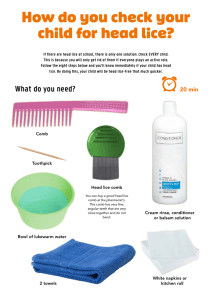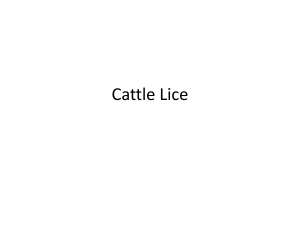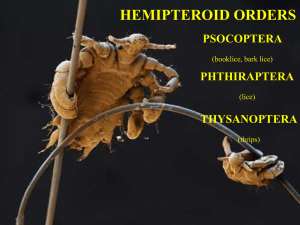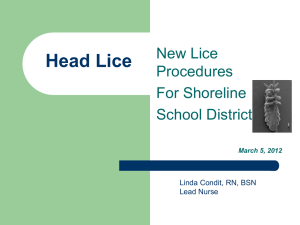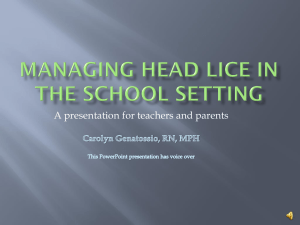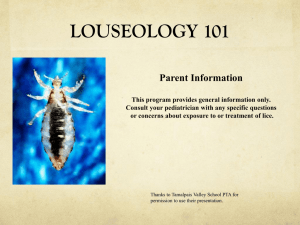Head lice: Are you Scratching for Anwers? A
advertisement
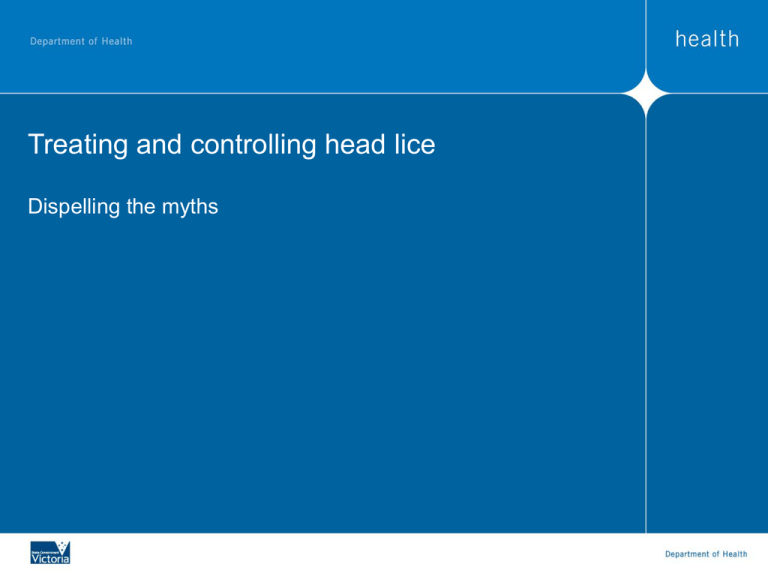
Treating and controlling head lice Dispelling the myths Head lice problems •Head lice problems occur even though parents try to stop them •Parents are given poor and conflicting advice and information •These myths often come from trusted sources Photo: Professor Rick Speare Myths about head lice Kids with lice scratch or itch 50% don’t Head lice jump or fly from head to head Head lice can’t jump or fly Lice live in carpets, beds and clothes Lice live only on heads More myths One treatment is enough One treatment will not get rid of lice Everyone in the family should be treated Treat only family members with live lice Some products prevent head lice Tie long hair back and check for lice regularly Head lice are selective about their home Head lice like all hair – clean, dirty, long, short… Some facts • Eggs are laid close to the scalp • They hatch after 6 or 7 days • There are 3 nymph (baby) stages before maturity (adult) which is 10 days after hatching • Lice live for about 30 days spending their entire life on the human head • Females lay 3 to 8 eggs per day More facts • Head lice are easy to kill • In two schools with at least 50 cases of head lice in each 1000 hats were checked and no lice were found on them • In a primary school where 7000 lice were found on children’s heads none were found on the carpet. The great escape • Few lice ever fall off the head • Those that do are probably about to die • If healthy lice fall they generally die quickly, depending on how humid it is eg 24 hours in Townsville in the wet season 6 hours in Townsville in the dry season Head lice eggs (nits) • It is helpful to be able to identify the eggs • Sunlight or strong light and magnification may help • If a child has empty hatched eggs or dead eggs and no live lice or crawlers they do not have an active infection and no treatment is needed. Lice eggs have curved walls and will pop when squeezed Lice eggs have curved walls and will pop when squeezed Dead eggs have collapsed sides Hatched eggs have a flat top in profile To get rid of lice you have to stop them breeding Life cycle of a head louse Steps for treating head lice Step 1 Detection Step 2 Treatment Comb hair conditioner onto dry, brushed hair Use a licensed or registered product Divide hair in small (3-4cm) sections OR Comb sections 3 or 4 times Wipe onto a paper towel Look for lice and eggs Use the comb and conditioner method every 2 days until no lice are found for 10 days Step 3 Check for resistance Step 4 Retreatment If an insecticide has worked the lice will be dead in 20 minutes Reapply the product 7 days after the first treatment After this time check Are the lice moving? No the product has worked Yes the product has not worked For heavy infestations, retreat 7 days after the second treatment What if the lice aren’t dead? Lice resistance cannot be predicted - retreat as soon as possible using a product with a different active chemical Nothing works… The four reasons for treatment failure are: 1. Inadequate application 2. Lice are resistant to the chemical 3. Failure to re treat 4. Reinfection If you are having difficulties start at the top of the list and work down. Remember these points: • Always check for live lice before treating • No treatment kills 100% of the eggs • Re treat 7 days after the first application • Test to make sure the treatment has worked and change products if necessary • Head lice can be controlled but it takes a systematic approach. Need more information? www.health.vic.gov.au/headlice www.health.qld.gov.au/headlice Good luck and happy hunting!

